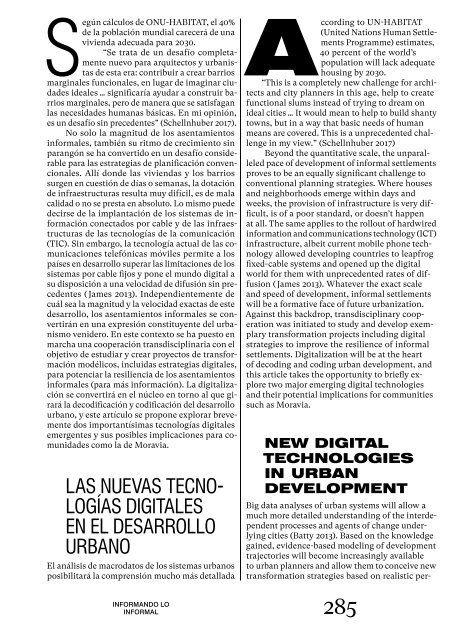Moravia Manifesto – Coding Strategies for Informal Neighborhoods
ISBN 978-3-86859-535-2 https://www.jovis.de/en/books/details/product/moravia-manifesto.html
ISBN 978-3-86859-535-2
https://www.jovis.de/en/books/details/product/moravia-manifesto.html
- No tags were found...
You also want an ePaper? Increase the reach of your titles
YUMPU automatically turns print PDFs into web optimized ePapers that Google loves.
Según cálculos de ONU-HABITAT, el 40%<br />
de la población mundial carecerá de una<br />
vivienda adecuada para 2030.<br />
“Se trata de un desafío completamente<br />
nuevo para arquitectos y urbanistas<br />
de esta era: contribuir a crear barrios<br />
marginales funcionales, en lugar de imaginar ciudades<br />
ideales … significaría ayudar a construir barrios<br />
marginales, pero de manera que se satisfagan<br />
las necesidades humanas básicas. En mi opinión,<br />
es un desafío sin precedentes” (Schellnhuber 2017).<br />
No solo la magnitud de los asentamientos<br />
in<strong>for</strong>males, también su ritmo de crecimiento sin<br />
parangón se ha convertido en un desafío considerable<br />
para las estrategias de planificación convencionales.<br />
Allí donde las viviendas y los barrios<br />
surgen en cuestión de días o semanas, la dotación<br />
de infraestructuras resulta muy difícil, es de mala<br />
calidad o no se presta en absoluto. Lo mismo puede<br />
decirse de la implantación de los sistemas de in<strong>for</strong>mación<br />
conectados por cable y de las infraestructuras<br />
de las tecnologías de la comunicación<br />
(TIC). Sin embargo, la tecnología actual de las comunicaciones<br />
telefónicas móviles permite a los<br />
países en desarrollo superar las limitaciones de los<br />
sistemas por cable fijos y pone el mundo digital a<br />
su disposición a una velocidad de difusión sin precedentes<br />
( James 2013). Independientemente de<br />
cuál sea la magnitud y la velocidad exactas de este<br />
desarrollo, los asentamientos in<strong>for</strong>males se convertirán<br />
en una expresión constituyente del urbanismo<br />
venidero. En este contexto se ha puesto en<br />
marcha una cooperación transdisciplinaria con el<br />
objetivo de estudiar y crear proyectos de trans<strong>for</strong>mación<br />
modélicos, incluidas estrategias digitales,<br />
para potenciar la resiliencia de los asentamientos<br />
in<strong>for</strong>males (para más in<strong>for</strong>mación). La digitalización<br />
se convertirá en el núcleo en torno al que girará<br />
la decodificación y codificación del desarrollo<br />
urbano, y este artículo se propone explorar brevemente<br />
dos importantísimas tecnologías digitales<br />
emergentes y sus posibles implicaciones para comunidades<br />
como la de <strong>Moravia</strong>.<br />
LAS NUEVAS TECNO-<br />
LOGÍAS DIGITALES<br />
EN EL DESARROLLO<br />
URBANO<br />
El análisis de macrodatos de los sistemas urbanos<br />
posibilitará la comprensión mucho más detallada<br />
INFORMANDO LO<br />
INFORMAL<br />
According to UN-HABITAT<br />
(United Nations Human Settlements<br />
Programme) estimates,<br />
40 percent of the world’s<br />
population will lack adequate<br />
housing by 2030.<br />
“This is a completely new challenge <strong>for</strong> architects<br />
and city planners in this age, help to create<br />
functional slums instead of trying to dream on<br />
ideal cities … It would mean to help to build shanty<br />
towns, but in a way that basic needs of human<br />
means are covered. This is a unprecedented challenge<br />
in my view.” (Schellnhuber 2017)<br />
Beyond the quantitative scale, the unparalleled<br />
pace of development of in<strong>for</strong>mal settlements<br />
proves to be an equally significant challenge to<br />
conventional planning strategies. Where houses<br />
and neighborhoods emerge within days and<br />
weeks, the provision of infrastructure is very difficult,<br />
is of a poor standard, or doesn’t happen<br />
at all. The same applies to the rollout of hardwired<br />
in<strong>for</strong>mation and communications technology (ICT)<br />
infrastructure, albeit current mobile phone technology<br />
allowed developing countries to leapfrog<br />
fixed-cable systems and opened up the digital<br />
world <strong>for</strong> them with unprecedented rates of diffusion<br />
( James 2013). Whatever the exact scale<br />
and speed of development, in<strong>for</strong>mal settlements<br />
will be a <strong>for</strong>mative face of future urbanization.<br />
Against this backdrop, transdisciplinary co operation<br />
was initiated to study and develop exemplary<br />
trans<strong>for</strong>mation projects including digital<br />
strategies to improve the resilience of in<strong>for</strong>mal<br />
settlements. Digitalization will be at the heart<br />
of decoding and coding urban development, and<br />
this article takes the opportunity to briefly explore<br />
two major emerging digital technologies<br />
and their potential implications <strong>for</strong> communities<br />
such as <strong>Moravia</strong>.<br />
NEW DIGITAL<br />
TECHNOLOGIES<br />
IN URBAN<br />
DEVELOPMENT<br />
Big data analyses of urban systems will allow a<br />
much more detailed understanding of the interdependent<br />
processes and agents of change underlying<br />
cities (Batty 2013). Based on the knowledge<br />
gained, evidence-based modeling of development<br />
trajectories will become increasingly available<br />
to urban planners and allow them to conceive new<br />
trans<strong>for</strong>mation strategies based on realistic per<br />
285


















